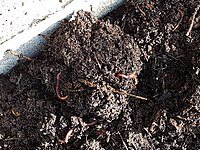
Photo from wikipedia
Sewage sludge derived biochar (SSDB) was used as a supplementary material for municipal sewage sludge (SS) and wood chips mixtures (WC) treated by combined composting and vermicomposting. SSDB added to… Click to show full abstract
Sewage sludge derived biochar (SSDB) was used as a supplementary material for municipal sewage sludge (SS) and wood chips mixtures (WC) treated by combined composting and vermicomposting. SSDB added to the mixture before composting resulted in significantly higher reproduction rate: on week 4 the number of cocoons increased by 213% when compared to the mixture with no biochar. On week 6 the average number of juveniles increased 11-fold in the mixture with biochar added before composting and 5-fold in the mixtures with biochar added after composting when compared to the mixture with no biochar. Biochar added before composting reduced bioavailability of Cd and Zn to E. fetida. The biochar-added vermicomposts showed good fertilizing properties except for elevated concentrations of Cr. The pH of all vermicomposts was in the range of 5.27-5.61. The obtained vermicomposts can be used as a growing medium for horticultural purposes or as an amendment in calcareous soils.
Journal Title: Bioresource technology
Year Published: 2017
Link to full text (if available)
Share on Social Media: Sign Up to like & get
recommendations!